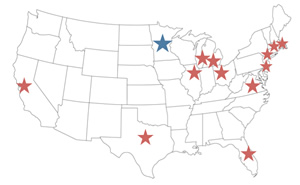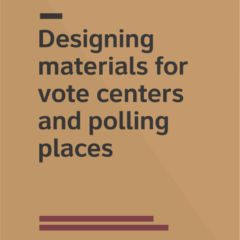Poll workers and election integrity
How do interactions between poll workers, technology, and other election materials support better elections?
Election integrity is more than just technology. Watching poll workers set up and open the polls on Election Day, and then close them at the end of the night, we saw teams whose attitudes ranged from the most basic requirement of maintaining an orderly process for voting to a focus to taking broad responsibility for ensuring that “my election” ran smoothly.
Election days can be chaotic — you don’t deploy over a million temporary workers and not get some variation in their diligence and effectiveness. That reality has to be part of the plan. Polling places with well-thought-out routines of running a polling place and scenario-based training can make poll workers truly effective in their vital role in administering elections.
What makes a good polling place?
In 19 elections in 12 states from November 2012 to November 2013, our team of researchers observed poll workers as they opened and closed their polling places. These elections included both presidential and local elections, with a variety of voting systems and local procedures.
When we asked poll workers what made a good election, we heard a progression of attitudes, from a shallow to a deep sense of ownership of the polling place. They said they were responsible for
- Running the polling place – maintaining order and comfort for voters
- Following procedures – completing all procedures correctly
- Accounting for paperwork – filling in all forms and reports to ensure that all votes are accounted for
- “My election” – focusing on the overall operation of their polling place as part of the entire election
At best, they approached integrity as the outcome of all the election procedures that support trust in the election.
How much information do poll workers need?
There is a lot of paperwork associated with an election from manuals to all the forms, checklists, and reconciliation sheets. Jurisdictions face what we call the “Goldilocks problem” of finding a balance in how much training and paperwork to give poll workers to support them in their work.
Some jurisdictions took a minimalist approach. Poll workers got a short manual, a dozen forms for documenting tallies and incidents, a poll book, and the phone number for the elections office.
In others, poll workers seemed awash in fat manuals and piles of forms, with reams of paper used in each polling place. We saw places where they spent as much time sorting through the paperwork that was supposed to be helping them as they did doing the work the checklists were meant to support.
No jurisdiction was perfect but we did not see a threat to the integrity of an election because of tools or aids for poll workers. The most problematic activity of the day is reconciliation at the end of the day. The morning is easy – unpack everything, check the voting systems, and open the polls. But in the evening, tired teams have to make sure that all the counts of voters and ballots, and other supplies agree.
Better manuals with well-written manuals and instructions, well-designed polling place forms, and clear checklists can make it easier for poll workers to take responsibility for running great elections.
Designing materials for vote centers and polling places
Templates and samples of envelopes and other materials, free to use and adapt
- Role-based checklists
- Survival guide template
- Supplies placemats



